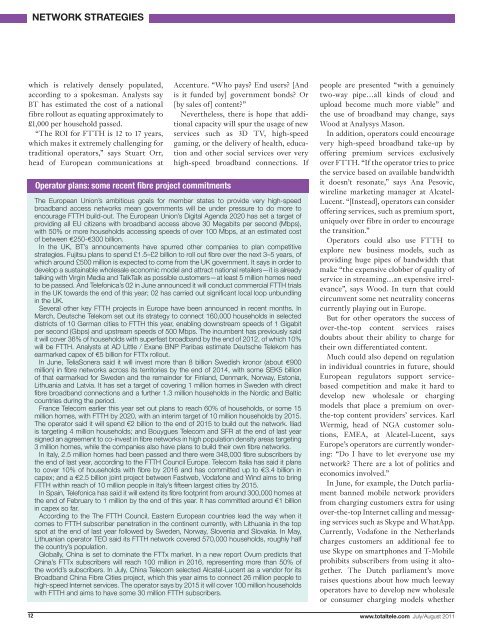ASIA MAJOR - Total Telecom
ASIA MAJOR - Total Telecom
ASIA MAJOR - Total Telecom
You also want an ePaper? Increase the reach of your titles
YUMPU automatically turns print PDFs into web optimized ePapers that Google loves.
netWorK StrAteGIeS<br />
which is relatively densely populated,<br />
according to a spokesman. Analysts say<br />
bT has estimated the cost of a national<br />
fibre rollout as equating approximately to<br />
£1,000 per household passed.<br />
“The roi for fTTh is 12 to 17 years,<br />
which makes it extremely challenging for<br />
traditional operators,” says stuart orr,<br />
head of european communications at<br />
Operator plans: some recent fibre project commitments<br />
Accenture. “who pays? end users? [And<br />
is it funded by] government bonds? or<br />
[by sales of] content?”<br />
nevertheless, there is hope that additional<br />
capacity will spur the usage of new<br />
services such as 3d TV, high-speed<br />
gaming, or the delivery of health, education<br />
and other social services over very<br />
high-speed broadband connections. if<br />
The European Union’s ambitious goals for member states to provide very high-speed<br />
broadband access networks mean governments will be under pressure to do more to<br />
encourage FTTH build-out. The European Union’s Digital Agenda 2020 has set a target of<br />
providing all EU citizens with broadband access above 30 Megabits per second (Mbps),<br />
with 50% or more households accessing speeds of over 100 Mbps, at an estimated cost<br />
of between E250-E300 billion.<br />
In the UK, BT’s announcements have spurred other companies to plan competitive<br />
strategies. Fujitsu plans to spend £1.5–£2 billion to roll out fibre over the next 3–5 years, of<br />
which around £500 million is expected to come from the UK government. It says in order to<br />
develop a sustainable wholesale economic model and attract national retailers—it is already<br />
talking with Virgin Media and TalkTalk as possible customers—at least 5 million homes need<br />
to be passed. And Telefonica’s 02 in June announced it will conduct commercial FTTH trials<br />
in the UK towards the end of this year; 02 has carried out significant local loop unbundling<br />
in the UK.<br />
Several other key FTTH projects in Europe have been announced in recent months. In<br />
March, Deutsche Telekom set out its strategy to connect 160,000 households in selected<br />
districts of 10 German cities to FTTH this year, enabling downstream speeds of 1 Gigabit<br />
per second (Gbps) and upstream speeds of 500 Mbps. The incumbent has previously said<br />
it will cover 36% of households with superfast broadband by the end of 2012, of which 10%<br />
will be FTTH. Analysts at AD Little / Exane BNP Paribas estimate Deutsche Telekom has<br />
earmarked capex of E5 billion for FTTx rollout.<br />
In June, TeliaSonera said it will invest more than 8 billion Swedish kronor (about E900<br />
million) in fibre networks across its territories by the end of 2014, with some SEK5 billion<br />
of that earmarked for Sweden and the remainder for Finland, Denmark, Norway, Estonia,<br />
Lithuania and Latvia. It has set a target of covering 1 million homes in Sweden with direct<br />
fibre broadband connections and a further 1.3 million households in the Nordic and Baltic<br />
countries during the period.<br />
France <strong>Telecom</strong> earlier this year set out plans to reach 60% of households, or some 15<br />
million homes, with FTTH by 2020, with an interim target of 10 million households by 2015.<br />
The operator said it will spend €2 billion to the end of 2015 to build out the network. Iliad<br />
is targeting 4 million households; and Bouygues <strong>Telecom</strong> and SFR at the end of last year<br />
signed an agreement to co-invest in fibre networks in high population density areas targeting<br />
3 million homes, while the companies also have plans to build their own fibre networks.<br />
In Italy, 2.5 million homes had been passed and there were 348,000 fibre subscribers by<br />
the end of last year, according to the FTTH Council Europe. <strong>Telecom</strong> Italia has said it plans<br />
to cover 10% of households with fibre by 2016 and has committed up to E3.4 billion in<br />
capex; and a E2.5 billion joint project between Fastweb, Vodafone and Wind aims to bring<br />
FTTH within reach of 10 million people in Italy’s fifteen largest cities by 2015.<br />
In Spain, Telefonica has said it will extend its fibre footprint from around 300,000 homes at<br />
the end of February to 1 million by the end of this year. It has committed around E1 billion<br />
in capex so far.<br />
According to the The FTTH Council, Eastern European countries lead the way when it<br />
comes to FTTH subscriber penetration in the continent currently, with Lithuania in the top<br />
spot at the end of last year followed by Sweden, Norway, Slovenia and Slovakia. In May,<br />
Lithuanian operator TEO said its FTTH network covered 570,000 households, roughly half<br />
the country’s population.<br />
Globally, China is set to dominate the FTTx market. In a new report Ovum predicts that<br />
China’s FTTx subscribers will reach 100 million in 2016, representing more than 50% of<br />
the world’s subscribers. In July, China <strong>Telecom</strong> selected Alcatel-Lucent as a vendor for its<br />
Broadband China Fibre Cities project, which this year aims to connect 26 million people to<br />
high-speed Internet services. The operator says by 2015 it will cover 100 million households<br />
with FTTH and aims to have some 30 million FTTH subscribers.<br />
people are presented “with a genuinely<br />
two-way pipe…all kinds of cloud and<br />
upload become much more viable” and<br />
the use of broadband may change, says<br />
wood at Analysys Mason.<br />
in addition, operators could encourage<br />
very high-speed broadband take-up by<br />
offering premium services exclusively<br />
over fTTh. “if the operator tries to price<br />
the service based on available bandwidth<br />
it doesn’t resonate,” says Ana pesovic,<br />
wireline marketing manager at Alcatellucent.<br />
“[instead], operators can consider<br />
offering services, such as premium sport,<br />
uniquely over fibre in order to encourage<br />
the transition.”<br />
operators could also use fTTh to<br />
explore new business models, such as<br />
providing huge pipes of bandwidth that<br />
make “the expensive clobber of quality of<br />
service in streaming…an expensive irrelevance”,<br />
says wood. in turn that could<br />
circumvent some net neutrality concerns<br />
currently playing out in europe.<br />
but for other operators the success of<br />
over-the-top content services raises<br />
doubts about their ability to charge for<br />
their own differentiated content.<br />
Much could also depend on regulation<br />
in individual countries in future, should<br />
european regulators support servicebased<br />
competition and make it hard to<br />
develop new wholesale or charging<br />
models that place a premium on overthe-top<br />
content providers’ services. karl<br />
wermig, head of ngA customer solutions,<br />
eMeA, at Alcatel-lucent, says<br />
europe’s operators are currently wondering:<br />
“do i have to let everyone use my<br />
network? There are a lot of politics and<br />
economics involved.”<br />
in June, for example, the dutch parliament<br />
banned mobile network providers<br />
from charging customers extra for using<br />
over-the-top internet calling and messaging<br />
services such as skype and whatApp.<br />
currently, Vodafone in the netherlands<br />
charges customers an additional fee to<br />
use skype on smartphones and T-Mobile<br />
prohibits subscribers from using it altogether.<br />
The dutch parliament’s move<br />
raises questions about how much leeway<br />
operators have to develop new wholesale<br />
or consumer charging models whether<br />
12 www.totaltele.com July/August 2011




